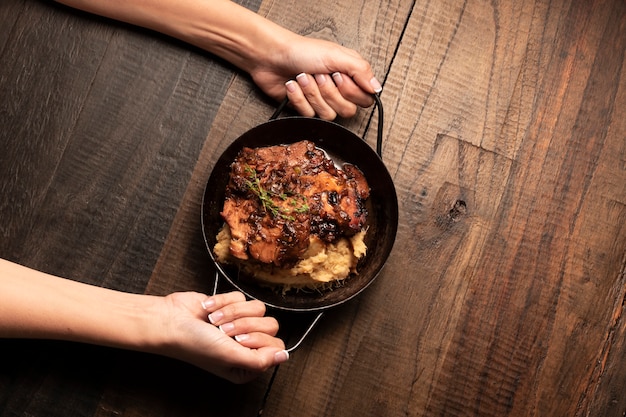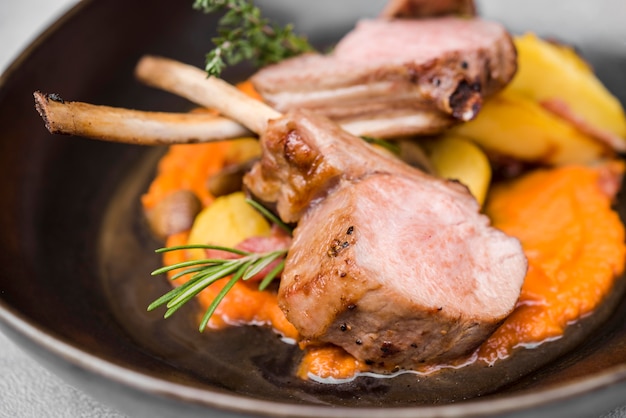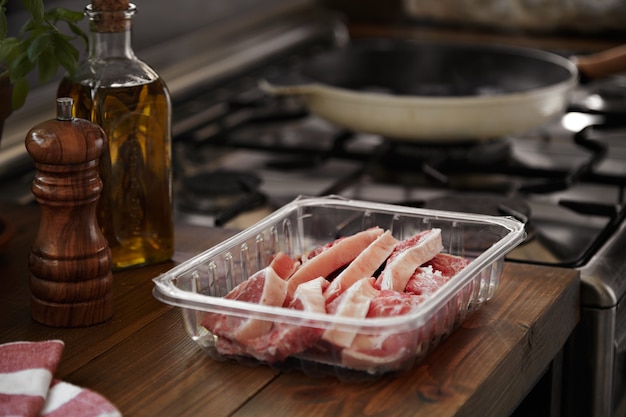(Part 1) The Science Behind a perfect pork loin

Understanding the "Why" Behind the Recipe
Before we dive into the details, let’s talk about the science behind roasting a pork loin. It's all about temperature and time, and getting those two elements right is crucial to a delicious result.
Think of it this way: you want that luscious, crispy exterior, but you also want the inside to be tender and juicy. We’re aiming for that “medium” doneness, which means cooking the pork loin to a safe internal temperature of 145°F (63°C) but continuing until it reaches about 150°F (66°C). This ensures it’s cooked through without becoming dry.
Oven Temperature: The Key to Even Cooking
Now, a lot of recipes suggest a high oven temperature of 350°F (175°C). But, in my experience, this can lead to a dry, overcooked pork loin. I’ve found that a lower oven temperature of 325°F (160°C) gives the meat more time to cook evenly and retain its moisture. This slower cooking process allows the internal temperature to rise gradually, leading to a more tender and flavorful result.
Estimating roasting time: A General Guide
For a 2 lb pork loin, you're looking at a general roasting time of about 45 to 60 minutes at 325°F (160°C). But remember, every oven is different. Don't solely rely on a timer. The real hero here is a trusty meat thermometer! It’s your secret weapon to ensuring that pork loin is cooked to perfection.
(Part 2) Getting Ready: Prepping for Roasting Success

Choosing the Right Pork Loin: The Foundation for Flavor
The first step to a delicious pork loin roast is selecting the right cut. You want to look for a pork loin that's firm to the touch, with a nice, even color. I usually opt for a boneless loin because it’s easier to handle and slice. But if you prefer bone-in, go for it! Just remember that it might take a little longer to cook.
When you’re at the butcher counter, make sure there’s no visible fat or any discoloration. A fresh, high-quality cut of meat will make a big difference in the final taste.
Seasoning and Rubbing: A Symphony of Flavors
The magic of seasoning really comes to life here. I’m a big fan of simple, classic flavors that let the pork loin shine. I start with a blend of salt, pepper, and garlic powder. It’s a tried-and-true combination that always delivers.
But feel free to get creative! Add a pinch of paprika for a subtle smoky flavor, or a sprinkle of dried rosemary or thyme for a hint of earthiness. You can even create your own unique blend based on your preferences.
After applying the seasoning, I like to rub a bit of olive oil on the pork loin. This helps to create a beautiful golden-brown crust during the roasting process. It’s all about that perfect balance of texture and flavor!
Optional Extras: Adding Depth and Complexity
For an extra touch of luxury, you can stuff the pork loin with flavorful ingredients. Think herbs, garlic, or even a slice of bacon! Just make sure you tie it securely with kitchen twine so the stuffing stays in place during cooking.
One of my favorite stuffing combinations is a mixture of sage, rosemary, and thyme. It adds a lovely earthy flavor that complements the pork perfectly.
(Part 3) The Roasting Process: Bringing the Pork Loin to Life

Getting Started: The Right Oven and Placement
Preheat your oven to 325°F (160°C). This gives the oven time to reach the ideal temperature for consistent cooking. While the oven preheats, place the pork loin in a roasting pan. I always recommend using a rack to elevate the loin, allowing air to circulate around it for more even cooking.
The First 30 Minutes: Building the Crust
Now, for the first 30 minutes of roasting, resist the urge to open the oven door. We’re aiming to create a consistent heat environment to develop that beautiful, crispy crust. This initial browning is what adds a layer of complexity to the flavor profile.
Checking for Doneness: The Meat Thermometer’s Role
After 30 minutes, it’s time to call in the big guns – your trusty meat thermometer! Use it to check the internal temperature of the pork loin. It should be at least 120°F (49°C). If it’s not, roast for another 10-15 minutes until it reaches that temperature.
The Resting Period: Allowing Flavors to Mingle
Once the pork loin reaches 150°F (66°C) and the juices run clear, it’s time for the most important step of all: resting. Take the pork loin out of the oven and let it rest for at least 10 minutes before slicing.
Why rest? As the meat cooks, the juices are pushed towards the center. When you slice it right away, those delicious juices will spill out, leaving you with a dry, disappointing meal.
Resting allows the juices to redistribute evenly throughout the meat. It’s a simple step that makes a world of difference in terms of texture and flavor.
(Part 4) The Importance of Resting: The Secret to juicy pork loin
The Science Behind Resting: Maximizing Moisture
Resting is truly essential for a juicy, tender pork loin. It's all about moisture retention and flavor redistribution. As the pork loin cooks, the muscle fibers contract, forcing the juices to the center. When you cut into the meat immediately, those juices are released, leaving the pork dry and bland.
But when you allow the pork loin to rest, the muscle fibers relax, allowing the juices to redistribute evenly. This results in a juicy, flavorful, and incredibly tender pork loin that will melt in your mouth.
How Long to Rest: The Ideal Timeframe
For a 2 lb pork loin, 10-15 minutes of resting is the perfect timeframe. This allows the juices to settle back into the meat without causing it to cool too much. Don't worry about the pork loin getting cold during this time. The residual heat from the roasting process will keep it warm enough to serve.
(Part 5) Serving and Enjoying Your Pork Loin: A Culinary Celebration
Slicing and Presentation: Making a Statement
After resting, slice the pork loin into thick, juicy pieces. I like to slice it on a diagonal, as it makes the pieces look more impressive. It’s all about that visual appeal, right?
Serve the pork loin with your favorite sides. Roasted vegetables, mashed potatoes, or a green salad all go perfectly with it.
Tips for Serving: Elevating the Presentation
For a truly impressive presentation, you can serve the pork loin on a platter, garnished with fresh herbs and a drizzle of pan sauce. It’s the kind of presentation that will make your guests feel special.
Don’t forget to offer a gravy boat of pan sauce for those who like a little extra flavor.
(Part 6) The Art of the Pan Sauce: Harnessing Hidden Flavor
Extracting the Flavour: Turning Scraps into Sauce
Have you ever noticed those delicious brown bits stuck to the bottom of the roasting pan? They’re pure flavor! Don't throw them away! Here’s how to make a delicious pan sauce that will elevate your pork loin to another level:
1. Pour off any excess fat from the roasting pan. You want to get rid of the excess fat so the sauce isn’t too greasy.
2. Add a cup of broth (chicken or pork broth works well) to the pan. This will create the base for your sauce.
3. Scrape the bottom of the pan with a wooden spoon, loosening up those brown bits. These browned bits are packed with flavor. They’re the secret ingredient to a truly delicious pan sauce.
4. Bring the broth to a boil, then reduce heat and simmer for a few minutes until it thickens slightly. This will help to develop the sauce’s richness and depth.
5. Strain the sauce through a fine-mesh sieve to remove any bits. This will give you a smooth, elegant sauce.
You now have a delicious, flavorful pan sauce to serve with your pork loin. It’s the perfect finishing touch that will add another layer of complexity and richness to your meal.
(Part 7) Troubleshooting Common Problems: Tackling the Unexpected
Overcooked Pork Loin: Restoring Moisture and Tenderness
Overcooked pork loin can be a bit dry and tough. If this happens, don’t despair! There are ways to restore moisture and tenderness. Try adding a little bit of moisture to it. A drizzle of pan sauce or a sprinkle of broth can help. You can also try slicing the pork loin thinly and serving it with a side of creamy sauce, like mashed potatoes or a creamy mushroom sauce.
Undercooked Pork Loin: Ensuring Safety and Doneness
If you're worried that your pork loin might be undercooked, simply pop it back in the oven for a few more minutes. Use your meat thermometer to check the internal temperature. It should be at least 145°F (63°C). If it’s not, cook it for a few more minutes until it reaches that safe temperature.
(Part 8) Variations and Tips for Success: Elevating Your Pork Loin Game
Citrus and Herbs: A Burst of Fresh Flavor
For a more citrusy flavour, try adding lemon or orange zest to your seasoning rub. A sprinkle of fresh thyme or rosemary also works well. The citrus notes add a bright and refreshing touch, while the herbs enhance the savory character of the pork loin.
Honey Glazing: A Touch of Sweetness
For a sweet and sticky glaze, try brushing the pork loin with a mixture of honey and soy sauce during the last 15 minutes of cooking. The glaze will caramelize as it cooks, creating a beautiful golden-brown crust and a rich, sweet flavor.
The Importance of a Good Thermometer: Your Culinary Companion
Invest in a good meat thermometer! It's the best way to ensure your pork loin is cooked to perfection. Don't rely solely on visual cues. A meat thermometer will give you a precise reading of the internal temperature, ensuring that the pork loin is cooked through and safe to eat.
Don't Overcrowd the Pan: Ensuring Even Cooking
If you're roasting more than one pork loin, make sure they have enough space to cook evenly. Don't overcrowd the pan. This will prevent the pork loin from steaming instead of roasting, resulting in a less flavorful and less evenly cooked dish.
(Part 9) Beyond the Recipe: Expanding Your Pork Loin Horizons
From the Oven to the Grill: Exploring New Techniques
You can also grill a pork loin! Just make sure you use indirect heat and keep an eye on the temperature. This means grilling over a bed of coals or with the heat source away from the pork loin. I love to grill pork loin with a sweet and smoky rub, and then serve it with a side of grilled pineapple. The smoky flavor adds a new dimension to the pork loin, and the pineapple provides a refreshing counterpoint.
Pork Loin in Different Cuisines: A Global culinary adventure
Pork loin is a versatile cut of meat that can be used in a variety of cuisines. You can find recipes for pork loin in Italian, French, Asian, and Mexican cuisines. Don't be afraid to experiment with different flavours and cooking techniques. You might just discover your new favourite pork loin recipe.
(Part 10) FAQs - Your Pork Loin Questions Answered
Q1: What happens if I overcook my pork loin?
An overcooked pork loin will be dry and tough. If this happens, try adding a little bit of moisture to it. A drizzle of pan sauce or a sprinkle of broth can help. You can also try slicing the pork loin thinly and serving it with a side of creamy sauce, like mashed potatoes or a creamy mushroom sauce.
Q2: How do I know if my pork loin is cooked through?
The best way to tell if your pork loin is cooked through is to use a meat thermometer. It should reach an internal temperature of 145°F (63°C). You can also check the colour of the meat. It should be a nice, even pink colour.
Q3: Can I roast a pork loin with the bone in?
Yes, you can roast a pork loin with the bone in. It will take a little longer to cook, so add about 15-20 minutes to your roasting time.
Q4: What are some good side dishes to serve with pork loin?
Roasted vegetables, mashed potatoes, green salads, and rice are all great side dishes to serve with pork loin.
Q5: Can I freeze pork loin?
Yes, you can freeze pork loin. Wrap it tightly in plastic wrap and then place it in a freezer-safe bag. It will keep in the freezer for up to 3 months.
I hope this article has provided you with all the information you need to roast a 2 lb pork loin to perfection. Now go out there and impress your family and friends with a delicious, home-cooked meal!
Everyone is watching

How to Cook Frozen Lobster Tails Perfectly: A Step-by-Step Guide
RecipesLobster. Just the word conjures up images of lavish meals, special occasions, and a taste of luxury. But let's...

Pigs in a Blanket Cooking Time: How Long to Bake for Perfect Results
RecipesAh, pigs in a blanket. Just the name conjures up images of those delightful little parcels of crispy pastry en...

Pork Fillet Cooking Time: How Long to Cook It Perfectly
RecipesPork fillet, or tenderloin as it's sometimes called, is a real favourite in our house. It's so versatile, and...

The Ultimate Guide to Cooking Delicious Frankfurters
RecipesLet's face it, we all love a good frankfurter. It's a classic, simple, and always satisfying. But let's be rea...

Wolf Meat Recipes: A Guide to Cooking Wild Game
RecipesLet's be honest, you don't see wolf meat at your local butcher shop every day. It's a bit of a wild card, but ...
